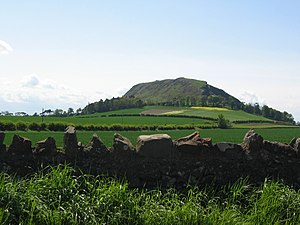Traprain Law
| Traprain Law | |
| East Lothian | |
|---|---|
 Traprain Law | |
| Summit: | 725 feet NT581746 55°57’47"N, 2°40’19"W |
Traprain Law is a 725-foot-high hill in East Lothian, standing some four miles east of the county town, Haddington. It is the site of an ancient oppidum or hill fort, which covered at its maximum extent about 40 acres and must have been a veritable town. Whether it was a seasonal meeting place or permanent settlement is a matter for speculation.
The hill was already a place of burial by around 1500 BC, and showed evidence of occupation and signs of ramparts after 1000 BC. The ramparts were rebuilt and re-aligned many times in the following centuries. Excavations have shown it was occupied in the late Iron Age from about AD 40 through the last quarter of the 2nd century (about the time that the Antonine Wall was manned). Following the Roman withdrawal to the line of Hadrian's Wall, Trapain Law it was occupied from about 220 almost uninterruptedly until about 400 when an impressive new rampart was built, then within a few decades the site was abandoned.
In the 1st century the Romans recorded the Votadini as the British tribe in the area, and Traprain Law is generally thought to have been one of their major settlements. The Votadini were known in their own tongue as the Gododdin, of the epic Old Welsh poem Y Gododdin. The capital of their kingdom is thought to have been on Traprain Law, before it was moving to Din Eidyn (believed to be Edinburgh's Castle Hill.
Name
The hill's name is taken from that of a local hamlet. The element "Law" is simply means "hill" (from the Old English hlaw) and is the common name for hills from the Tees to the Forth.
The hill has been known as Traprain Law only from the late 18th century, taking its name from a local hamlet. Before that, it is found on old maps as Dunpendyrlaw[1]. Locally, and particularly amongst fishermen who use it as a landmark, it is still referred to as Dunpelder.
Archaeology
A team led by Curle and Cree began the first excavations in 1914 and continued them until 1923, finding layers of fragmentary stone and timber houses under the turf.
Traprain Treasure
In 1919, they recovered a hoard of silver plate. Consisting of over 53 pounds of sliced-up Roman era silver, the discovery was made in a pit within the boundary of the settlement earlier uncovered. Four coins were discovered with the hoard; one of the Emperor Valens, three of Arcadius and one of Honorius, the last emperor to claim to rule in Britain, which dates the find to some point in the fifth century AD. The quality of some of the items suggests that they may have come from as far afield as Rome, Ravenna, or possibly Antioch or Constantinople.[2]
Most objects had been crushed and hacked to pieces, and only some were left intact. A great deal of the find was table silver, but there were also early Christian items and remnants from a Roman officer's uniform.
It had originally been thought that the objects had been brought back from a raid abroad, as the objects had been split up ready for division. Later finds such as at Mildenhall, Suffolk showed that silverware of this nature was certainly in use in Roman Britain. A further suggestion is that it had been brought back on a raid by the Gododdin across Hadrian's Wall. Furthermore, it has also been suggested that the silver was in payment for mercenary service to protect weaker tribes from the inroads of the Scotis, Picts, and English, the silver split up as bullion due to lack of adequate coinage.
Further excavations were made in 1939 by Cruden and in 1947 by Gerhard Bersu.
The collection was restored where appropriate and sent to the National Museum of Antiquities in Edinburgh and now is in the care of the Royal Museum of Scotland.
References
- ↑ Scots Place Names. Retrieved 23 april 2008, from: http://www.scotsplacenames.com
- ↑ HMSO Information Sheet 7/1980, The Treasure of Traprain. Joanna Close-Brooks, 1980.
- Ian Armit, Scotland's Hidden History Tempus (in association with Historic Scotland) 1998, ISBN 0-7486-6067-4
- R.W. Feachem, "The Fortifications on Traprain Law," Proceedings of the Society of Antiquaries of Scotland, 89 (1955-6), 284-9.
- Richard Feachem, Guide to Prehistoric Scotland London: Batsford, 1977 ISBN 0-7134-3264-0
- Stuart Piggott, Scotland Before History Edinburgh: University Press, 1982 ISBN 0-85224-348-0
Photo gallery
Outside links
- "Great Sites: Trapain Law", Ian Armit, British Archaeology, February 2001
- http://www.roman-britain.org/places/traprain_law.htm



